Finding the Way Home
A Sierra Junkie’s Journey Back to the Good Old Days
It's a school night in 1988. I am ten years old. I come out of my bedroom to find my dad sitting at our Apple IIgs computer. Over his shoulder I see a little man walking toward the front door of Lefty's bar. He walks with his arms bent like a robot's and is wearing what my father tells me is a leisure suit. My father types "open door" and the man goes into the bar. Before long I've pulled up a chair. I'm calling out commands faster than my father can type them.
I know from conversations with other gamers that my introduction to Sierra is not all that unique. Leisure Suit Larry in the Land of the Lounge Lizards was like contraband in the 80s, traveling from one computer to the next on pirated 5.25" floppies. I had played Zork and Scott Adams' text adventures before this, but LSL was my first exposure to the stuff adventure game legends are made of. Little did I know these games would become a huge part of my life.
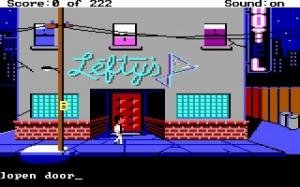 My father and I finished Leisure Suit Larry in a few evenings. He covered my eyes during certain scenes, and very carefully explained others. ("What's a rubber, Dad? What's Spanish Fly? Why did that lady tie Larry to the bed?") When we finished that first game my father took me down to Egghead Software, where I bought a copy of King’s Quest 1 with my birthday money. I was hooked.
My father and I finished Leisure Suit Larry in a few evenings. He covered my eyes during certain scenes, and very carefully explained others. ("What's a rubber, Dad? What's Spanish Fly? Why did that lady tie Larry to the bed?") When we finished that first game my father took me down to Egghead Software, where I bought a copy of King’s Quest 1 with my birthday money. I was hooked.
Sierra games were then, and still are, my absolute favorites. Somehow I completely missed the boat on Monkey Island. I liked Myst and 7th Guest, but neither could compare to those graphic quests I'd become so fond of. I cried the day my mom took me to Egghead to buy a Space Quest game and the store manager told us they were no longer selling Apple IIgs software. Soon after that we got a Mac, then an external CD-ROM, then a better Mac—all to support my Sierra habit.
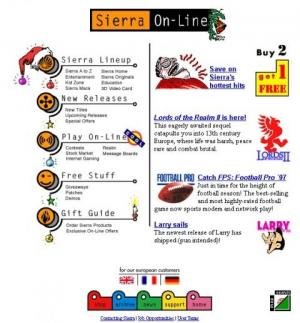 It wasn't just the games that I liked. It was Sierra. Ken and Roberta Williams were like the parents of this big family I belonged to. Even before the Internet, they had managed to create a community among their customers. Every quarter when InterAction magazine arrived in the mail, I got to see what new treasures Sierra would bring me next. The first time I ventured online it was to seek out Sierra's website. I, like so many others, dreamed of graduating from college and moving to Oakhurst to become a part of the Sierra team.
It wasn't just the games that I liked. It was Sierra. Ken and Roberta Williams were like the parents of this big family I belonged to. Even before the Internet, they had managed to create a community among their customers. Every quarter when InterAction magazine arrived in the mail, I got to see what new treasures Sierra would bring me next. The first time I ventured online it was to seek out Sierra's website. I, like so many others, dreamed of graduating from college and moving to Oakhurst to become a part of the Sierra team.
The last adventure game I played before starting college was Phantasmagoria. I finished it my first night in the dorm, before my roommate arrived, wondering how I would be able to feed this addiction once I was sharing the room. Something funny happened while I was in college, though. I suddenly didn't have any spare time for gaming. Again, from talking to others who share my passion, I know I'm not the only one who had this problem. I played a few games here and there—finished Police Quest: Open Season, which hadn't run on our computer at home due to a bug, and treated myself to Gabriel Knight: The Beast Within after a particularly stressful semester. But my connection to Sierra was broken. I lost track of which sequels would be coming out when. My subscription to InterAction lapsed. That's okay, I told myself, when I get out of school I'll get a newer, faster computer, and I'll have time to play as many games as I want. I graduated from college in 2000, acquired a laptop, and went to Best Buy with money to burn.
 You all know how this story ends. There was nothing there. Nada. Tumbleweed rolling through the aisles. Of course by that I mean there were plenty of games on the shelves, boxes and boxes and more boxes, but none of them were adventures. The store didn't even have an adventure section. After some hard searching I finally found Gabriel Knight 3. It was the only adventure game in the entire store. Soon after this, I visited Sierra's website and found that it, too, had changed. No more welcoming cartoon art and folksy web copy. Sierra, it seemed, had been taken over by some corporate entity. The company I'd grown to know and love all those years no longer existed.
You all know how this story ends. There was nothing there. Nada. Tumbleweed rolling through the aisles. Of course by that I mean there were plenty of games on the shelves, boxes and boxes and more boxes, but none of them were adventures. The store didn't even have an adventure section. After some hard searching I finally found Gabriel Knight 3. It was the only adventure game in the entire store. Soon after this, I visited Sierra's website and found that it, too, had changed. No more welcoming cartoon art and folksy web copy. Sierra, it seemed, had been taken over by some corporate entity. The company I'd grown to know and love all those years no longer existed.
I was lucky. After much hunting and surfing, I found my way home. I read an article that said adventure games were dead, but that didn't stop me. I found a few websites dedicated to the games I'd once played. Then I discovered abandonware. And then, much to my relief, I found this little band of people just like me who claimed there were still games I'd enjoy. Adventure games were not dead—just the company that had made them great.
I've accepted that no matter how many times the adventure genre rises from the ashes, the old Sierra is gone. When Ken and Roberta Williams sold Sierra and retired, the spirit of the company they'd created went with them. But the fans are still around. Not only that, thanks to the Internet the fans have taken over where Ken and Roberta left off. Some are preserving Sierra's legacy by making box art, promotional materials, and game soundtracks available to the public. Others are building new games from Sierra's technology. The nine sites featured in this article are only a handful in what is still a very active community.
Recently, while playing the newly-released fan game Peasant's Quest, I found that guiding an AGI sprite across the screen holds the same excitement that it did back in 1988. What is it about those old Sierra games? Tom Lewandowski, founder of Quest Studios, states it very well: "Sierra had something special back in the 1980s and early 1990s that hasn't been duplicated well in today's adventures. That combination of talent and desire was like magic."
That something special may not be present in all of today's new releases, but it's not gone for good. Are you ready to relive the magic? These sites will take you there.
Vintage Sierra
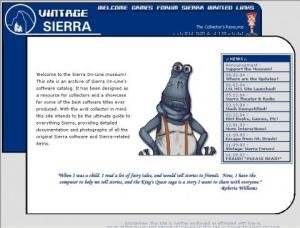 Vintage Sierra is a virtual Sierra museum run by a true collector. Vintage Sierra's webmaster, Josh, started playing Sierra games in the 80s, but it wasn't until after Sierra was sold that he realized how much those games meant to him. He started collecting but had trouble finding information about all the games, versions, and packaging variations out there. As a result he started this site, where he shares his collection and gives other Sierra fans invaluable information for building their own. Release information and box scans are available for many Sierra oldies, including the Hi-Res Adventures—such as Mystery House and Wizard and the Princess—that started it all. Vintage Sierra has tips on what to look for and how to avoid fraudulent copies, as well as a forum that gives Sierra junkies a place to swap games and talk about collecting. The site also includes history about Sierra, cover scans of many InterAction magazines, and a newly opened Theater and Radio Room that hosts promotional movies from way-back-when.
Vintage Sierra is a virtual Sierra museum run by a true collector. Vintage Sierra's webmaster, Josh, started playing Sierra games in the 80s, but it wasn't until after Sierra was sold that he realized how much those games meant to him. He started collecting but had trouble finding information about all the games, versions, and packaging variations out there. As a result he started this site, where he shares his collection and gives other Sierra fans invaluable information for building their own. Release information and box scans are available for many Sierra oldies, including the Hi-Res Adventures—such as Mystery House and Wizard and the Princess—that started it all. Vintage Sierra has tips on what to look for and how to avoid fraudulent copies, as well as a forum that gives Sierra junkies a place to swap games and talk about collecting. The site also includes history about Sierra, cover scans of many InterAction magazines, and a newly opened Theater and Radio Room that hosts promotional movies from way-back-when.
Sierra Planet
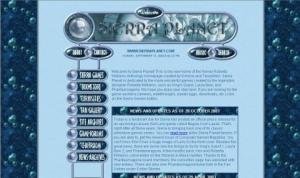 Sierra Planet is a site dedicated to Roberta Williams' games. You'll find a ton of information here about King's Quest, Laura Bow, and the first Phantasmagoria game. The site includes game reviews, screenshots, patches, and Easter eggs. The Ali's Bookstore (get the reference?) section has a comprehensive listing of Sierra-related books and strategy guides. And for a neat trip down memory lane, check out the archived King's Quest Collection and Phantasmagoria: Stagefright pages that webmistress Kimmie saved before Sierra took them down from the official site.
Sierra Planet is a site dedicated to Roberta Williams' games. You'll find a ton of information here about King's Quest, Laura Bow, and the first Phantasmagoria game. The site includes game reviews, screenshots, patches, and Easter eggs. The Ali's Bookstore (get the reference?) section has a comprehensive listing of Sierra-related books and strategy guides. And for a neat trip down memory lane, check out the archived King's Quest Collection and Phantasmagoria: Stagefright pages that webmistress Kimmie saved before Sierra took them down from the official site.
SpaceQuest.net
 What Sierra Planet is to Roberta Williams' games, SpaceQuest.net is to the Space Quest series. Even if you're not a Space Quest fan, this site is worth a visit. It does an excellent job of preserving the humor, quirkiness, and overall fun of the early Sierra products. Every Space Quest game is accounted for here, including a compilation of news and rumors about the on-again, off-again Space Quest 7 (may it rest in peace). For each game in the series, webmaster Frans van Hofwegen has posted in-depth information about the storyline and key characters, along with Easter eggs and fun things to try. Frans also shares scans of the original documentation and hints laid out as they were in the old "magic pen" hint books. Other goodies include two personalized letters from Sierra's hint department, a few InterAction magazine articles, scans of the short-lived Space Quest comic book series, and instructions for making your very own Andromedan snout. There's also a very detailed article on building the perfect computer to run your old Sierra favorites.
What Sierra Planet is to Roberta Williams' games, SpaceQuest.net is to the Space Quest series. Even if you're not a Space Quest fan, this site is worth a visit. It does an excellent job of preserving the humor, quirkiness, and overall fun of the early Sierra products. Every Space Quest game is accounted for here, including a compilation of news and rumors about the on-again, off-again Space Quest 7 (may it rest in peace). For each game in the series, webmaster Frans van Hofwegen has posted in-depth information about the storyline and key characters, along with Easter eggs and fun things to try. Frans also shares scans of the original documentation and hints laid out as they were in the old "magic pen" hint books. Other goodies include two personalized letters from Sierra's hint department, a few InterAction magazine articles, scans of the short-lived Space Quest comic book series, and instructions for making your very own Andromedan snout. There's also a very detailed article on building the perfect computer to run your old Sierra favorites.
AGD Interactive
 If you want to relive that Christmas morning you found a brand new VGA, point-and-click adventure under the tree, check out AGD Interactive. AGD stands for "anonymous game developers"—the handle this group has been using for the past three years as they remake Sierra classics in VGA, point-and-click style (think King's Quest 5 and Space Quest 4). Their first project was a straight King's Quest 1 remake in 2001, complete with voice acting that included Josh Mandel reprising his role as King Graham. This was followed by an ambitious King's Quest 2 remake in 2002 which was, in my opinion, the best game of the year. The team, then known as Tierra Entertainment, didn't just update KQ2's graphics and interface, they also implemented a vastly expanded storyline that made sense of the seemingly random elements of the original game. (Ever wonder why Dracula's cloak was under Little Red Riding Hood's grandmother's bed? Now we know!) Both games are available for free download at their site.
If you want to relive that Christmas morning you found a brand new VGA, point-and-click adventure under the tree, check out AGD Interactive. AGD stands for "anonymous game developers"—the handle this group has been using for the past three years as they remake Sierra classics in VGA, point-and-click style (think King's Quest 5 and Space Quest 4). Their first project was a straight King's Quest 1 remake in 2001, complete with voice acting that included Josh Mandel reprising his role as King Graham. This was followed by an ambitious King's Quest 2 remake in 2002 which was, in my opinion, the best game of the year. The team, then known as Tierra Entertainment, didn't just update KQ2's graphics and interface, they also implemented a vastly expanded storyline that made sense of the seemingly random elements of the original game. (Ever wonder why Dracula's cloak was under Little Red Riding Hood's grandmother's bed? Now we know!) Both games are available for free download at their site.
The Anonymous Game Developers have always maintained that while the Sierra remakes have taught them the tricks of game development, they someday want to turn their talents to commercial adventure games. This year the team renamed themselves AGD Interactive, which suggests they may be getting away from their fan game roots and headed in that direction. But we'll have at least one more nostalgic gem from them—their Quest for Glory 2 VGA remake is expected to come out later this year. And considering the quality of their remakes, I can't say I'll be disappointed when they finally do turn their efforts to original projects.
Quest Studios
 Quest Studios is THE resource for Sierra music. Husband and wife team Tom and Dianne Lewandowski have been composing MIDI music together since they met online in the 80s. They have made a bunch of Sierra game soundtracks available in the original MIDI and Roland MT-32 formats, as well as MP3 and Ogg. Most of Sierra's Quest games are represented here, as well as such favorites as Laura Bow, Gabriel Knight, and Freddy Pharkas. Quest Studios is also responsible for the digital music packs that go with AGDI's King's Quest remakes. In addition, this site links to a number of useful patches and utilities that will help you get the older games working on your newer computer.
Quest Studios is THE resource for Sierra music. Husband and wife team Tom and Dianne Lewandowski have been composing MIDI music together since they met online in the 80s. They have made a bunch of Sierra game soundtracks available in the original MIDI and Roland MT-32 formats, as well as MP3 and Ogg. Most of Sierra's Quest games are represented here, as well as such favorites as Laura Bow, Gabriel Knight, and Freddy Pharkas. Quest Studios is also responsible for the digital music packs that go with AGDI's King's Quest remakes. In addition, this site links to a number of useful patches and utilities that will help you get the older games working on your newer computer.
The Ultimate AGI & SCI Web Site
 Although it's not updated very often, The Ultimate AGI & SCI Web Site is an excellent resource for anyone interested in the technology behind Sierra's classics. AGI (Adventure Game Interpreter) was Sierra's first graphical game engine. It introduced gamers to the elements we came to identify with Sierra, such as white description boxes outlined in red and sprites who walked with both arms bent. AGI was later replaced with SCI (Sierra Creative Interpreter), which was first seen in such games as King's Quest 4 and Police Quest 2. Although Sierra abandoned these engines years ago, they're still supported by a thriving fan base. This site includes AGI and SCI applications, tutorials, demos, and links to fan games that use these engines. You'll also find some nice scans of box art, Sierra-related magazine articles, and ads from the good old days. Brian Provinciano, the fan behind this site, also maintains active pages for SCI Studio and GBAGI, which runs AGI games on the Game Boy Advance—an application he almost managed to sell to Vivendi, Sierra's parent company.
Although it's not updated very often, The Ultimate AGI & SCI Web Site is an excellent resource for anyone interested in the technology behind Sierra's classics. AGI (Adventure Game Interpreter) was Sierra's first graphical game engine. It introduced gamers to the elements we came to identify with Sierra, such as white description boxes outlined in red and sprites who walked with both arms bent. AGI was later replaced with SCI (Sierra Creative Interpreter), which was first seen in such games as King's Quest 4 and Police Quest 2. Although Sierra abandoned these engines years ago, they're still supported by a thriving fan base. This site includes AGI and SCI applications, tutorials, demos, and links to fan games that use these engines. You'll also find some nice scans of box art, Sierra-related magazine articles, and ads from the good old days. Brian Provinciano, the fan behind this site, also maintains active pages for SCI Studio and GBAGI, which runs AGI games on the Game Boy Advance—an application he almost managed to sell to Vivendi, Sierra's parent company.
Good Old Adventures
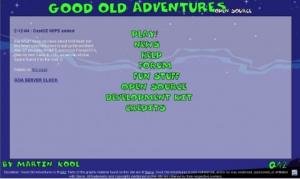 Good Old Adventures is an AGI chat experience that could become so much more. For the time being, GOA gives you the opportunity to impersonate an AGI character (such as Rosella, Roger Wilco, a fairy, or a goat) and chat with others. There's usually no one there when I am but there's still something eerily compelling about wandering around Llewdor or the Lytton PD—not just watching an AGI character do it, but doing it myself. Of course if you coordinate with another Sierra junkie you can go on at the same time and share the experience. This site has not been updated in some time and message board posts suggest that the project has been abandoned, although it has been made available as open source. However, the site's creator Martin Kool recently hinted on GOA's message board that a second-generation version is in the works.
Good Old Adventures is an AGI chat experience that could become so much more. For the time being, GOA gives you the opportunity to impersonate an AGI character (such as Rosella, Roger Wilco, a fairy, or a goat) and chat with others. There's usually no one there when I am but there's still something eerily compelling about wandering around Llewdor or the Lytton PD—not just watching an AGI character do it, but doing it myself. Of course if you coordinate with another Sierra junkie you can go on at the same time and share the experience. This site has not been updated in some time and message board posts suggest that the project has been abandoned, although it has been made available as open source. However, the site's creator Martin Kool recently hinted on GOA's message board that a second-generation version is in the works.
Al Lowe's Humor Site
 If there’s one thing prevalent in Al Lowe's games, it's humor. Al Lowe's Humor Site, run by the creator of the legendary Leisure Suit Larry series, is meant to make its visitors laugh, but the real treasures are the inside information Al shares about LSL, Freddy Pharkas, and Torin's Passage. This site is full of stories about the good old days at Sierra, tips for getting the games running on modern systems, goodies such as LSL sheet music and ring tones, and answers for the copy protection Al says he was forced to include in his games. Detailed design documents for several of Al's games are available for download, giving us a unique look into the inner workings of that company we so longed to be part of. Al also shares what he knows about the cancelled LSL8: Lust in Space and the upcoming Magna Cum Laude—the first Leisure Suit Larry game he has not been involved in.
If there’s one thing prevalent in Al Lowe's games, it's humor. Al Lowe's Humor Site, run by the creator of the legendary Leisure Suit Larry series, is meant to make its visitors laugh, but the real treasures are the inside information Al shares about LSL, Freddy Pharkas, and Torin's Passage. This site is full of stories about the good old days at Sierra, tips for getting the games running on modern systems, goodies such as LSL sheet music and ring tones, and answers for the copy protection Al says he was forced to include in his games. Detailed design documents for several of Al's games are available for download, giving us a unique look into the inner workings of that company we so longed to be part of. Al also shares what he knows about the cancelled LSL8: Lust in Space and the upcoming Magna Cum Laude—the first Leisure Suit Larry game he has not been involved in.
Sierra On-Line Fan Site
(Note: You'll have to register to read many of the posts on this site. This is so Ken can maintain an email list of people who are interested in his site. You won't be spammed.)
 Where better to end our romp through Sierra history than with the man who started it all? The Sierra On-Line Fan Site, maintained by Sierra founder and former CEO Ken Williams, serves two purposes. First and foremost, it gives adventure fans around the world the opportunity to communicate with the man behind the company we loved so much. Secondly, it gives Ken a testing ground for the web software he's currently developing. Many of us used to dream of working for Ken Williams when we grew up. Now, by helping him test his software, we can. This isn't the prettiest site out there, but Ken freely admits he's a developer, not a designer. His approachability and willingness to answer questions makes this site a must-visit for any old-school Sierra fan.
Where better to end our romp through Sierra history than with the man who started it all? The Sierra On-Line Fan Site, maintained by Sierra founder and former CEO Ken Williams, serves two purposes. First and foremost, it gives adventure fans around the world the opportunity to communicate with the man behind the company we loved so much. Secondly, it gives Ken a testing ground for the web software he's currently developing. Many of us used to dream of working for Ken Williams when we grew up. Now, by helping him test his software, we can. This isn't the prettiest site out there, but Ken freely admits he's a developer, not a designer. His approachability and willingness to answer questions makes this site a must-visit for any old-school Sierra fan.
To help preserve Sierra's history, many members have uploaded scans of box art, documentation, InterAction magazine covers, and other Sierra memorabilia. But the best aspect of this site is the community itself. Reading posts from other fans with memories so similar to my own is the closest I've come to finding the Sierra that was lost. And when Ken shares memories of his Sierra days, opinions about the industry, and funny stories about his life with Roberta, it's almost as if I've found my way home.












